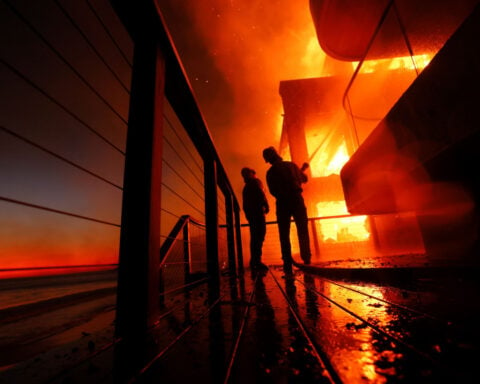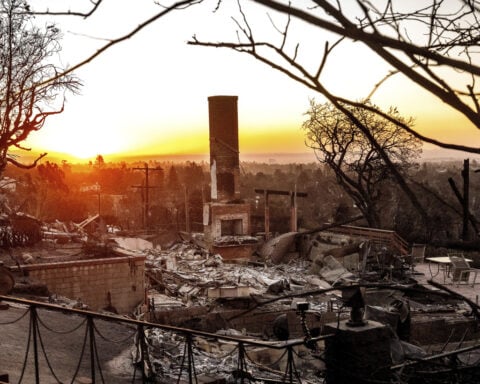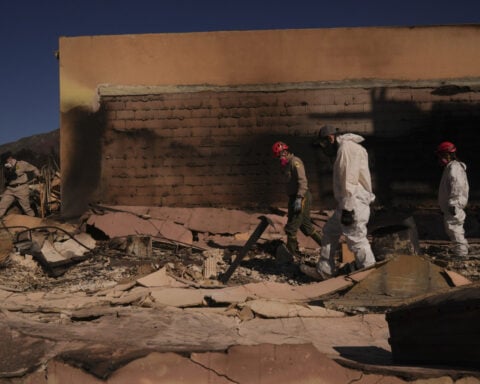The levels of the crucial heat-trapping gases in the atmosphere reached historic highs last year, growing at near-record fast paces, according to the U.S. National Oceanic and Atmospheric Administration.
Carbon dioxide, the most important and abundant of the greenhouse gases caused by humans, rose in 2023 by the third highest amount in 65 years of record keeping, NOAA announced Friday. Scientists are also worried about the rapid rise in atmospheric levels of methane, a shorter-lived but more potent heat-trapping gas. Both jumped 5.5% over the past decade.
The 2.8 parts per million increase in carbon dioxide airborne levels from January 2023 to December, wasn't as high as the jumps were in 2014 and 2015, but they were larger than every other year since 1959, when precise records started. Carbon dioxide's average level for 2023 was 419.3 parts per million, up 50% from pre-industrial times.
Last year's methane's jump of 11.1 parts per billion was lower than record annual rises from 2020 to 2022. It averaged 1922.6 parts per billion last year. It has risen 3% in just the past five years and jumped 160% from pre-industrial levels showing faster rates of increase than carbon dioxide, said Xin “Lindsay” Lan, the University of Colorado and NOAA atmospheric scientist who did the calculations.
“Methane’s decadal spike should terrify us,” said Stanford University climate scientist Rob Jackson, who heads the Global Carbon Project that tracks worldwide emissions of carbon dioxide but wasn't part of NOAA's report. “Fossil fuel pollution is warming natural systems like wetlands and permafrost. Those ecosystems are releasing even more greenhouse gases as they heat up. We’re caught between a rock and a charred place.”
Methane emissions in the atmosphere come from natural wetlands, agriculture, livestock, landfills and leaks and intentional flaring of natural gas in the oil and gas industry.
Methane is responsible for about 30% of the current rise in global temperature, with carbon dioxide to blame for about twice as much, according to the International Energy Agency. Methane traps about 28 times the heat per molecule as carbon dioxide but lasts a decade or so in the atmosphere instead of centuries or thousands of years like carbon dioxide, according to the U.S. Environmental Protection Agency.
Carbon dioxide and methane levels have been higher in the far ancient past, but it was before humans existed.
The third biggest human-caused greenhouse gas, nitrous oxide, jumped 1 part per billion last year to record levels, but the increases were not as high as those in 2020 and 2021. Nitrous oxide, which lasts about a century in the atmosphere, comes from agriculture, burning of fuels, manure and industrial processes, according to the EPA.
“As these numbers show we still have a lot of work to do to make meaningful progress in reducing the amount of greenhouse gases accumulating in the atmosphere,” NOAA Global Monitoring Laboratory Director Vanda Grubisic said in statement.
Companies across the globe last year pledged massive — almost complete — cuts in methane emissions from the oil and gas industry in a new initiative that could trim future rises in temperature by a tenth of a degree Celsius. And the EPA issued a final rule to reduce oil and gas industry generated methane emissions.
But the past five years, methane levels have risen faster than any time in NOAA record-keeping. And recent studies have shown that government efforts to track methane are vastly underestimating the pollution going into the air from the energy industry.
Studies of the specific isotopes of methane in the air show much of the increased methane is from microbes, pointing to spiking emissions from wetlands and perhaps agriculture and landfills, but not as much the energy industry, Lan said.
“I'm still mostly concerned about carbon dioxide emissions,” Lan said.
Carbon dioxide emissions going into the air from burning fossil fuels and making cement hit an all time high last year of 36.8 billion metric tons, twice the amount spewed into the air 40 years ago, according to Global Carbon Project. But about half of what's coming out of smokestacks and tailpipes are temporarily sucked up and stored by trees and oceans, keeping it out of the atmosphere, Lan said.
Methane doesn't have that temporary carbon storage that carbon dioxide has, Lan said.
The shift last year from a three-year La Nina, the natural cooling of parts of the central Pacific that changes weather worldwide, to a warm El Nino, played a role in dampening methane's increasing rate in the air and spiking carbon dioxide levels, Lan said.
That's because methane's biggest emissions comes from wetlands, which during a La Nina is wetter in much of the tropics, creating more microbes in the lush growth to release methane, Lan said. The La Nina ended mid year last year, giving way to a strong El Nino.
Carbon dioxide levels in the atmosphere tend to rise higher during hotter El Ninos, but the current one is starting to peter out, Lan said.
___
Read more of AP’s climate coverage at http://www.apnews.com/climate-and-environment
___
Follow Seth Borenstein on X at @borenbears
___
The Associated Press’ climate and environmental coverage receives financial support from multiple private foundations. AP is solely responsible for all content. Find AP’s standards for working with philanthropies, a list of supporters and funded coverage areas at AP.org.

 Italy, Albania, UAE sign deal for energy subsea interconnection
Italy, Albania, UAE sign deal for energy subsea interconnection
 European shares advance as bond yields ease; soft inflation powers UK stocks
European shares advance as bond yields ease; soft inflation powers UK stocks
 Bank Indonesia delivers surprise rate cut to support growth
Bank Indonesia delivers surprise rate cut to support growth
 Novak Djokovic breaks a tie with Roger Federer for the most Grand Slam matches in tennis history
Novak Djokovic breaks a tie with Roger Federer for the most Grand Slam matches in tennis history
 China's RedNote: what you need to know about the app TikTok users are flocking to
China's RedNote: what you need to know about the app TikTok users are flocking to
 British author Neil Gaiman denies ever engaging in non-consensual sex as more accusers come forward
British author Neil Gaiman denies ever engaging in non-consensual sex as more accusers come forward








